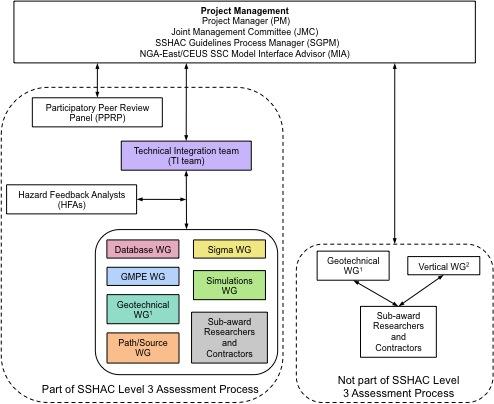NGA-East is a multi-disciplinary research project coordinated by the Pacific Earthquake Engineering Research center (PEER), with headquarters at the University of California, Berkeley. The project involves a large number of participating researchers from various organizations in academia, industry and government. The project is jointly sponsored by the U.S. Nuclear Regulatory Commission (NRC), the U.S. Department of Energy (DOE), the Electric Power Research Institute (EPRI) and the U.S. Geological Survey (USGS).
The objective of NGA-East is to develop a new ground motion characterization (GMC) model for the Central and Eastern North-American (CENA) region. The GMC model consists in a set of new ground motion prediction equations (GMPEs) for median and standard deviation of ground motions (GMs) and their associated weights in the logic-trees for use in probabilistic seismic hazard analyses (PSHA).
NGA-East Database: https://ngawest2.berkeley.edu/
A bit of history: project development
 NGA-East was originally developed as a science-based research project originally designed as a follow-up to the previous NGA project (referred to as NGA-West for clarity) that focused on the development of GMPEs for shallow crustal earthquakes in active tectonic regions. NGA-East evolved to a SSHAC Level 3 in early 2010 so that it would be consistent with the CEUS SSC project and to allow the products of these projects to be combined for use in Level 3 site-specific studies. As a result, the scope of work and the level of complexity of the project have increased considerably.
NGA-East was originally developed as a science-based research project originally designed as a follow-up to the previous NGA project (referred to as NGA-West for clarity) that focused on the development of GMPEs for shallow crustal earthquakes in active tectonic regions. NGA-East evolved to a SSHAC Level 3 in early 2010 so that it would be consistent with the CEUS SSC project and to allow the products of these projects to be combined for use in Level 3 site-specific studies. As a result, the scope of work and the level of complexity of the project have increased considerably.
What is SSHAC?
SSHAC stands for the “Senior Seismic Hazard Analysis Committee”, which is the entity that developed the SSHAC Guidelines detailed in the NUREG/CR-6372 document. The SSHAC assessment process can be used in the development of PSHA input models or in PSHA studies. The fundamental goal of a SSHAC assessment process is to carry-out properly and document completely the activities of evaluation and integration, defined as:
- Evaluation: The consideration of all the data, models, and methods proposed by the larger technical community that are relevant to the hazard analysis.
- Integration: Representing the center, body, and range of technically defensible interpretations in light of the evaluation process.
The SSHAC guidelines define four study levels, each higher level corresponding to an increase in complexity. Higher study levels are associated with a higher confidence that the center, body and range of technically defensible interpretations of the available data, models and methods have been captured in the final products. The SSHAC Level 3 was selected as appropriate to ensure the stability and transparency of the NGA-East products given the complexity, importance and regulatory concerns associated with the study. More details on the level of study and the SSHAC process are presented in NUREG/CR-6372, Hanks et al. (2009) and in NUREG 2117.
The SSHAC Level 3 assessment process requires a level of documentation and review that is much more demanding than what was carried out in other comparable research projects, such as NGA-West for example. This implies larger resources in both time and capital investment. In an effort to optimize the needs of the different agencies with the available resources, the SSHAC Level 3 study was assigned to tasks associated to NRC and DOE objectives only. The remaining “non-SSHAC” tasks and objectives will be addressed as typical research tasks coordinated by PEER.
NGA-East Objectives
Principal SSHAC Objective
To provide the best estimate of the distribution (median and standard deviation) of
average horizontal ground motions (PGA, PGV and 5%-damped Sa for T=0.01-10s) on hardrock sites located up to 1,000 km from future earthquakes in CENA with moment magnitudes in the 4.0 to 8.0 range, and to provide the epistemic uncertainty associated with this estimate.
Principal Non-SSHAC Objectives
– To develop site amplification models to account for site response effects on geo-materials
not defined as hard rock.
– To develop models to quantify the ground motions in the vertical direction of shaking.
Additional objectives include a close collaboration and integration activities with the following:
– CEUS Sesimic Source Characterization Project
– USGS National Seismic Hazard Mapping Program
– NGA-West 2 Project
Project Organization
As a result of the project evolution, the NGA-East organization features all the components of a SSHAC Level 3 project, but it also features groups from the original project model (Figure 1). An important feature of NGA-East is the inclusion of Working Groups (WGs) that support the TI Team and focus on specific technical areas. Some NGA-East WGs and technical tasks are not formally part of the SSHAC Level 3 process, but they are nonetheless important to the overall project. These are the Geotechnical and Vertical WGs shown in Figure 1. The role of the different groups and participants in Figure 1 are briefly summarized below and more details on roles in SSHAC studies are available in NUREG-CR-6372 and NUREG-2117. Note in Figure 1that the Geotechnical WG and sub-award researchers and contractors provide support to SSHAC and non-SSHAC tasks. In the context of the SSHAC process, the WGs essentially play the role of Resource Experts and the sub-award researchers and contractors play the role of Specialty Contractors. Some individuals from these two groups will also play a Proponent Expert role at specific times during the project.

Figure 1. NGA-East organization flowchart and lines of communications.

